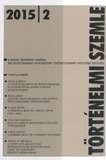 The second issue of Historical Review for 2015 has been published. Károly Goda’s study examines medieval Corpus Christi festivities and processions in a Central European context, arguing that with regard to the feast of the Eucharist the ecclesiastical sphere was in no way separated from the political one. Péter Tusor’s essay analyses in detail, in the framework of a research on the political role of the ecclesiastical estat, especially in the early modern era, and on the basis of newly discovered sources, the measures taken by its leader, György Lippay, primate of Hungary (1642-1666) in the interest if Miklós Zrínyi, ban of Croatia (1647-1664) in the court of Vienna during 1663–1664. Orsolya Völgyesi’s study hows the influence of Ferenc Kölcsey on the younger “reform” generation in the political environment of the 1830s. Viktória Kovács’s essay tries to shed light on the background to the landowning of the Premonstratensians examining and comparing different sources. János Buza’s paper deals with the characteristics of minting in Hungary before 1526. György Kurucz’s paper argues that the process of turning an uprising into a legitimate freedom fight for the elimination of the excesses of the Habsburg administration in the Kingdom of Hungary, including the recognition of the Hungarians as a negotiating party by the English and Dutch diplomacy at the beginning of the 18th century, was largely dependent on the military progresses made by the insurgent troops of Prince Ferenc Rákóczi II. Bálint Varga’s study attempts to answer the question, how 19th century historians tried to interpret „inconvenient” events (that after settling in the Carpathian Basin in the early 10th century, pagan and nomadic Magyar tribes led a series of military campaigns against the organized states of Christian Europe) in a way that they could still insert into the master narrative of the glorious national past, utilizing the required methodology of historiography. Miroslav Michaela’s study is dealing with an analysis of political and symbolic levels of the cult of St. Stephen in (Czecho)slovakia during the inter-war period.
The second issue of Historical Review for 2015 has been published. Károly Goda’s study examines medieval Corpus Christi festivities and processions in a Central European context, arguing that with regard to the feast of the Eucharist the ecclesiastical sphere was in no way separated from the political one. Péter Tusor’s essay analyses in detail, in the framework of a research on the political role of the ecclesiastical estat, especially in the early modern era, and on the basis of newly discovered sources, the measures taken by its leader, György Lippay, primate of Hungary (1642-1666) in the interest if Miklós Zrínyi, ban of Croatia (1647-1664) in the court of Vienna during 1663–1664. Orsolya Völgyesi’s study hows the influence of Ferenc Kölcsey on the younger “reform” generation in the political environment of the 1830s. Viktória Kovács’s essay tries to shed light on the background to the landowning of the Premonstratensians examining and comparing different sources. János Buza’s paper deals with the characteristics of minting in Hungary before 1526. György Kurucz’s paper argues that the process of turning an uprising into a legitimate freedom fight for the elimination of the excesses of the Habsburg administration in the Kingdom of Hungary, including the recognition of the Hungarians as a negotiating party by the English and Dutch diplomacy at the beginning of the 18th century, was largely dependent on the military progresses made by the insurgent troops of Prince Ferenc Rákóczi II. Bálint Varga’s study attempts to answer the question, how 19th century historians tried to interpret „inconvenient” events (that after settling in the Carpathian Basin in the early 10th century, pagan and nomadic Magyar tribes led a series of military campaigns against the organized states of Christian Europe) in a way that they could still insert into the master narrative of the glorious national past, utilizing the required methodology of historiography. Miroslav Michaela’s study is dealing with an analysis of political and symbolic levels of the cult of St. Stephen in (Czecho)slovakia during the inter-war period.
CONTENTS
STUDIES
Károly Goda: „Ecce panis angelorum”. Medieval Corpus Christi Festivities and Processions in Vienna and Buda in a Central European Perspective
Péter Tusor: The Primate, the Ban and the Court of Vienna (1663–1664)
Orsolya Völgyesi: The Generation of László Szalay in the Lure of Kölcsey
WORKSHOP
Viktória Kovács: The Background to the Landowning of the Premonstratensians of Lelesz at Szalóka
János Buza: The Draw Bench Thrown into the Danube. On Minting in Hungary before 1526
György Kurucz: Interests of Allied Powers, Protestant Sympathies, Military Realities: Prince Rákóczi’s Freedom Fight and the English Diplomatic Mediation
Bálint Varga: The Barbarian Past and the Glory of the Nation
Miroslav Michela: „A Home Should Be a Home to All Its Sons”. Cultural Representations of the Cult of Saint Stephen in Slovakia during the Interwar Period
Történelmi Szemle (Historical Review) is a periodical of the Institute of History of the Research Centre for the Humanities at the Hungarian Academy of Sciences. The language of the journal is Hungarian, but each article includes an abstract in English. Subscriptions can be made at any Hungarian post office, but issues of the journal (including older issues) can be bought or ordered from the Institute as well (postal address: MTA BTK Történettudományi Intézet, 1014 Budapest, Úri u. 53.; telephone: 224-6700/626; e-mail address: ).



